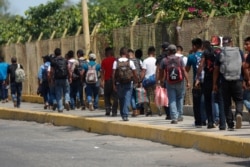This story was updated on July 16 at 4:22 a.m.
VOA Immigration Reporter Aline Barros contributed to this report from Washington.
WASHINGTON — The Trump administration is moving to block most asylum-seekers at America's southern border, a move that would largely affect Central Americans who cross through Mexico.
The administration's action, announced by the U.S. Departments of Justice and Homeland Security, bars people from applying for asylum in the U.S. if they traveled by land through another country where asylum was available before arriving in the United States, according to a 58-page federal document made public Monday.
In a statement, Attorney General William Barr noted a "dramatic increase in the number of aliens" arriving at the U.S.-Mexico border, adding that "[o]nly a small minority of these individuals" qualifies for asylum.
"The large number of meritless asylum claims places an extraordinary strain on the nation's immigration system, undermines many of the humanitarian purposes of asylum, has exacerbated the humanitarian crisis of human smuggling," Barr said.
The rule is set to take effect Tuesday and is expected to spark swift legal challenges.
"This thing should never get off the ground. It should be held up immediately [by the courts]," said immigration expert Tom Jawetz of the Washington-based Center for American Progress.
'Genuine' need
In order to enter the United States, asylum-seekers would have to show that they were denied relief in a third country — not their own, and not the U.S. Failing that, they would be turned away.
The U.S. has negotiated with Guatemala and Mexico over migration and asylum policies, as the Trump administration seeks to decrease the number of unauthorized southern border crossers and asylum-seekers.
Experts say the level of safety in countries stretching from Central America to the United States varies greatly.
The U.N. Refugee Agency said it is "deeply concerned" about the new U.S. rule, saying it "excessively curtails the right to apply for asylum, significantly raises the burden of proof on asylum seekers beyond the international legal standard, sharply curtails basic rights and freedoms of those who manage to meet it, and is not in line with international obligations."
While the rule would impact tens of thousands of Central Americans, who comprise the majority of unauthorized border crossers and asylum-seekers at America's southwest border, it applies to all asylum-seekers — including those from countries outside the region. In recent months, U.S. Border Patrol agents have noted an increase in asylum-seekers from central Africa and Haiti.
The rule would not apply to nationals of Mexico or Canada, countries that are contiguous to the United States.
U.S. President Donald Trump has long favored more restrictive immigration policies, challenging arrivals from Latin America, the Middle East, and several majority-Muslim African countries.
Monday's document spelling out the rule change differentiates between those who have a "genuine" need for asylum and those who do not, asserting that some are taking advantage of the U.S. system. It says the rule seeks to speed "relief to those who need it most (i.e., individuals who have no alternative country where they can escape persecution or torture or who are victims of a severe form of trafficking and thus did not volitionally travel through a third country to reach the United States)."
The new rule is the latest attempt by the Trump administration to hold back asylum-seekers at the Mexican border.
Since January, more than 15,000 people — largely from El Salvador, Guatemala, and Honduras — who sought asylum in the U.S. were returned to Mexico under the "Migrant Protection Protocols" to await their asylum case in U.S. immigration court.
Legal action
While the new regulation directs civil servants on how to carry out part of the U.S. immigration law, it does not change the law itself, which only Congress can alter.
"Fiddling around with regulations doesn't change the law," said Jason Dzubow, a Washington, D.C., attorney who focuses on asylum law.
Jawetz predicted U.S. courts will block the rule from taking effect.
"And then there will be further litigation around issuing a permanent injunction as you've seen with several other legal actions against this administration," Jawetz told VOA.
Such legal challenges are not new. Trump's attempts to implement travel bans also provoked a flurry of lawsuits.
It is unclear whether the roughly 8,400 nationals of the Northern Triangle countries who were granted asylum by the U.S. in 2017 — the last year Washington has published complete asylum data — would have qualified under the new regulation.
Although the regulation would curb who can apply for asylum, it allows for another measure of relief called "withholding of removal."
Under that provision, people who can demonstrate that their lives or freedom would be in jeopardy if deported to their home country could be sent to a safe third country, if that country accepts the individual.










